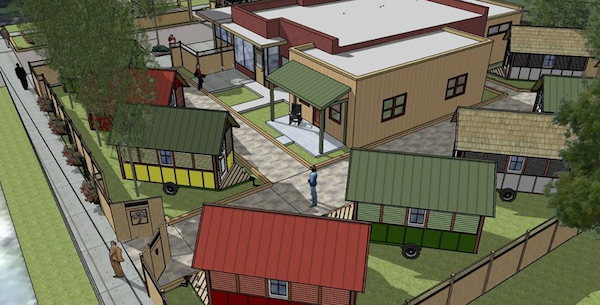WebStamp May 8, 2017
Tiny House Communities -Design Continued
Last issue’s article in WebStamp we began investigating the reasoning and benefits of developing tiny house communities within city neighbourhoods. The main reasons many are looking to downsize are to simplify their lifestyles and live inexpensively with the environment in mind. Our April 3rd article Tiny House Communities – Hindered by Bylaws showed how current legislation prevents many from achieving this goal of removing one of the stresses of everyday living.
We saw that we could put up to 4 tiny homes onto one average city lot. With the cost of a lot at around $200,000 and up makes it quite a substantial fee for many; where a ¼ of the cost can actually make it much more affordable to own a home. If we developed two lots beside each other, we could develop a THC (Tiny House Community) of 6 to 8 homes, with shared access paths, which will provide larger communal areas.
The City of Calgary has begun allowing Laneway Homes and relaxed the laws where people can live in tiny homes on wheels (classified as trailers parked in backyards) if they get a permit and connects to utilities. This type of legislation means one could actually apply for a development permit and shouldn’t have to jump through hurdles to get it.
Cost saving can be achieved with the connection of the utilities. Water and sewage would be one utility I feel would be a necessity in an urban environment, for obvious reasons. Since the homes are in close proximity to each other the costs of these connections would be significantly reduced. With electricity, there should be at least 3 choices. Connecting to the Grid, and Solar Power (also connected to the Grid) are the 2 selections that are currently a non-issue.Since these tiny houses wouldn’t require a significant amount of power, Off the Grid with solar and wind power would also be a viable choice, but currently not allowed.
Many of what people classify as tiny homes are around 200 to 400 sq. ft. and are on wheels making them easily movable as trailers. A collection of these units would give us a more efficient mobile home environment without paying costly pad rental. Instead of having to build foundations for permanent structures, creating concrete pads is more cost effective. Not having to take time to build a structure, mobile tiny houses can be easily placed, or removed, within a day, reducing the disruption impact to the neighbourhood.
Come back for the next issue of WebStamp where we will look into what part permanent structure tiny houses can play in tiny house communities.
Share This Article





